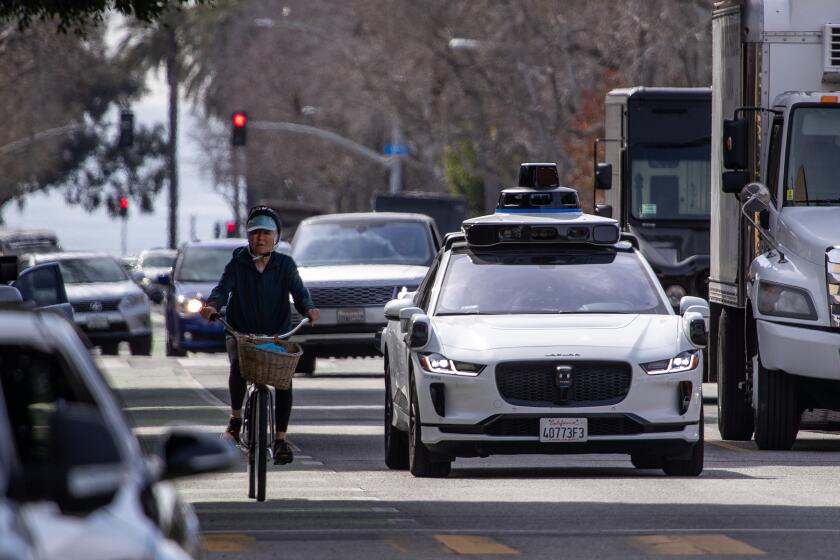Yes, America absolutely should annex Greenland and Canada. Here’s why

- Share via
According to Donald Trump and J.D. Vance, Greenland and Canada have everything to gain and nothing to lose from being annexed to the United States.
“Denmark hasn’t done a good job at keeping Greenland safe,” Vance said at America’s Pituffik Space Base in Greenland last week. Denmark, which oversees Greenland’s administration, hasn’t kept Greenland “safe from a lot of very aggressive incursions from Russia, China and other nations,” he added.
Trump talks as though Canada’s becoming the 51st state would be an economic win-win for both countries.
We do not have uninsured or underinsured residents. We do not have different qualities of insurance depending on a person’s employment....All Canadians have health insurance and need rather than wealth is what drives access to care.
— Danielle Martin, expert on Canadian healthcare
Leaving these assertions aside, it’s proper to note that the influence exerted by annexed lands is a two-way street.
And that’s why the U.S. should annex — needs to annex — both Greenland and Canada. Let’s start the process without delay.
Get the latest from Michael Hiltzik
Commentary on economics and more from a Pulitzer Prize winner.
You may occasionally receive promotional content from the Los Angeles Times.
The principal gain for Americans from making both countries part of the U.S. comes from their social policies. In both countries, they’re better than America’s in many respects. They cover more residents, provide greater benefits and have more support from political leaders across the partisan spectrum.
Let’s take a closer look at what Americans can learn from its putative new territories.
We’ll start with Canada.
Like the United States, Canada provides old-age pensions, though unlike in the U.S. these are partially paid out of general tax revenues. Canadians also can receive unemployment relief and workers’ compensation. The difference between the effectiveness of the two countries’ government pension programs can be measured by comparing their poverty rates for residents ages 65 and over. In Canada it was 14.5% in 2019-2022, in the U.S. it was 23.1%.
Acting Commissioner Leland Dudek leaves Social Security beneficiaries worried about their checks. They should be.
There are several notable differences between the American and Canadian safety nets. One is a child benefit. Canada provides parents as much as $7,787 Canadian (about $5,438 in U.S. currency) per child for children through age 5, and $6,570 Canadian (about $4,600) for children ages 6-17. The benefit phases out for those with incomes over $67,000 (about $47,000).
The U.S. child tax credit is currently $2,000 a year per child and is scheduled to drop to $1,000 in 2026. It phases out for couples earning $400,000.
Perhaps the most significant difference concerns the countries’ government healthcare programs. Canada’s system is a single-payer program, with the government paying for most necessary care; households can buy private plans to cover services that aren’t part of the government system, such as vision and dental services and outpatient prescriptions. But all Canadians are covered by the government program.
American politicians have tied themselves into knots trying to find negative things to say about Canada’s universal single-payer healthcare system.
A sterling example was provided by then-U.S. Sen. Richard Burr (R-N.C.), who during a 2014 Senate hearing grilled Danielle Martin, a Canadian expert on healthcare policy, about the supposed shortcomings of the Canadian system. Burr homed in on Canadians’ most common complaint about their system: the long waits for some services, largely resulting from a shortage of primary care doctors.
“On average, how many Canadian patients on a waiting list die each year, do you know?” Burr asked Martin, with a smirk suggesting he had just unshipped a “gotcha.” Martin batted it right back: “I don’t, sir, but I do know that there are 45,000 in America who die waiting because they don’t have insurance at all.”
Trump promised to leave Social Security alone, but his actions speak louder than his words
As Martin had said in her prepared statement: “We do not have uninsured or underinsured residents. We do not have different qualities of insurance depending on a person’s employment.... At substantially lower cost than in the U.S., all Canadians have health insurance and need rather than wealth is what drives access to care.”
The Canadian government pays for reproductive healthcare, including abortions. There are no gestational age restrictions, although most abortions are performed during the first trimester and those after 23 weeks require specialized care. There are no criminal penalties for performing abortions.
Those are obvious differences from the American experience. By law, federal funds can’t be spent on abortions. Since the Supreme Court overturned the 1973 Roe vs. Wade decision in 2022, individual states have imposed their own restrictions on abortion, sometimes by outlawing the procedure outright and even exposing those who perform abortions to criminal charges.
The consequences for maternal health in the U.S. have been horrific. In Canada, according to 2023 statistics, the maternal mortality rate per 100,000 live births was 12.22. The U.S. rate that year was 18.6.
More worrying was a trend seen in Texas, among the states with a strict ban on abortions, where maternal mortality rose sharply to 28.5 maternal deaths per 100,000 live births in 2022, a year after Texas banned abortions.
The social safety net in Greenland is a bit harder to analyze. For the most part Greenlanders enjoy the benefits of Danish policies.
Greenland’s social environment is also different from Denmark’s — its Indigenous population, which has its own social mores, is larger as a proportion of the population, and residents are concentrated in the giant island’s southwest. The island has a population of about 60,000, about a third of whom live in the capital, Nuuk.
Hiltzik: Inside the Bakersfield raids that showed how Trump’s immigration policies will sow chaos
The U.S. Border Patrol ran rampant through Bakersfield in what immigration advocates say was nothing but racial profiling aimed at intimidation. More such raids are coming.
Denmark’s social policies are among the most socially liberal in the world. According to a government website, tax-funded benefits for Danish citizens include paid parental leave that can total almost a full year, subsidized day care, a universal single-payer healthcare program with no copays except for prescriptions; dental care is typically provided by private plans. All medical and nursing education is free.
Denmark doesn’t have a minimum wage law, but collective bargaining agreements have resulted in a standard minimum of about $15.57 (U.S.) an hour — more than in most jurisdictions in the U.S., where the mandated federal minimum is $7.25 an hour.
Denmark recently liberalized its abortion law, raising the right to obtain abortion upon request to up to 18 weeks of pregnancy from 12 weeks, beginning June 1. Girls ages 15 or over don’t need parental consent. Abortions are free, covered by the government program.
The maternal mortality rate in Denmark is about 5 per 100,000 live births but may be higher in Greenland, where medical care is less accessible in remote communities.
The political cultures of the U.S., Canada and Greenland (or Denmark, if you prefer) are also divergent. Those other countries don’t seem to have the same proportion of crass blowhards in their political structure as the U.S. That’s not the same as saying they don’t have any crass blowhards in politics — Canadians will remember the escapades of former Toronto Mayor Rob Ford or the efforts by former Quebec Premier Rene Levesque to have his francophone province secede from English-speaking Canada.
Once all these factors are considered, another question arises: Why stop with Canada and Greenland? There are other countries that have managed to score higher than the U.S. in terms of the happiness of their populace.
The list has been led for years by Finland, followed by Denmark, Iceland, Sweden, the Netherlands and Norway, among others. On this roster, the U.S. ranked a dismal 24th in 2024, behind Mexico, Australia, New Zealand and, indeed, Canada.
Think of it this way. Going only by which countries might teach us how to make our people happier, if we could only make them part of the U.S. — the number of candidates for annexation comes to 23, not just two. Trump and Vance need to get down to work.
More to Read
Insights
L.A. Times Insights delivers AI-generated analysis on Voices content to offer all points of view. Insights does not appear on any news articles.
Viewpoint
Perspectives
The following AI-generated content is powered by Perplexity. The Los Angeles Times editorial staff does not create or edit the content.
Ideas expressed in the piece
- The article argues that annexing Greenland and Canada would benefit the U.S. by importing their superior social policies, including Canada’s universal healthcare system, which covers all citizens, and its child tax credit program[1][5].
- Proponents claim Canada’s maternal mortality rate (12.22 per 100,000 births) is lower than the U.S. (18.6 per 100,000), partly due to unrestricted abortion access and comprehensive reproductive care[1][5].
- Advocates highlight Denmark’s policies in Greenland, such as subsidized childcare, free medical education, and a $15.57/hour minimum wage, as models for U.S. reform[1].
- The article frames annexation as an opportunity to adopt Denmark’s 18-week abortion access window and Greenland’s lack of abortion restrictions, contrasting them with post-Roe U.S. state policies[1].
- Supporters suggest absorbing countries with higher happiness rankings, like Finland and Norway, could improve American well-being, citing the U.S.’s 24th-place global ranking[1][5].
Different views on the topic
- Canada’s ambassador to France condemned annexation threats as violations of the UN Charter[1], which prohibits “the threat or use of force against the territorial integrity… of any state”[1][3].
- Denmark asserts Greenland’s right to self-determination under the 2009 Self-Government Act, with Greenlanders pursuing independence through constitutional drafting[4][2].
- Analysts argue Trump’s rhetoric aims to exploit Greenland’s independence movement and Arctic security concerns[3], while Canada views the threats as economic coercion to renegotiate trade terms[3][5].
- The EU and Germany warned against unilateral border changes, emphasizing universal adherence to international law[1], as Greenland hosts strategic U.S. military infrastructure like Pituffik Space Base[3].
- Critics describe annexation as part of a broader imperialist pattern in U.S. history, risking destabilization of global norms and Canada-U.S. relations[5][3].
Get the latest from Michael Hiltzik
Commentary on economics and more from a Pulitzer Prize winner.
You may occasionally receive promotional content from the Los Angeles Times.














